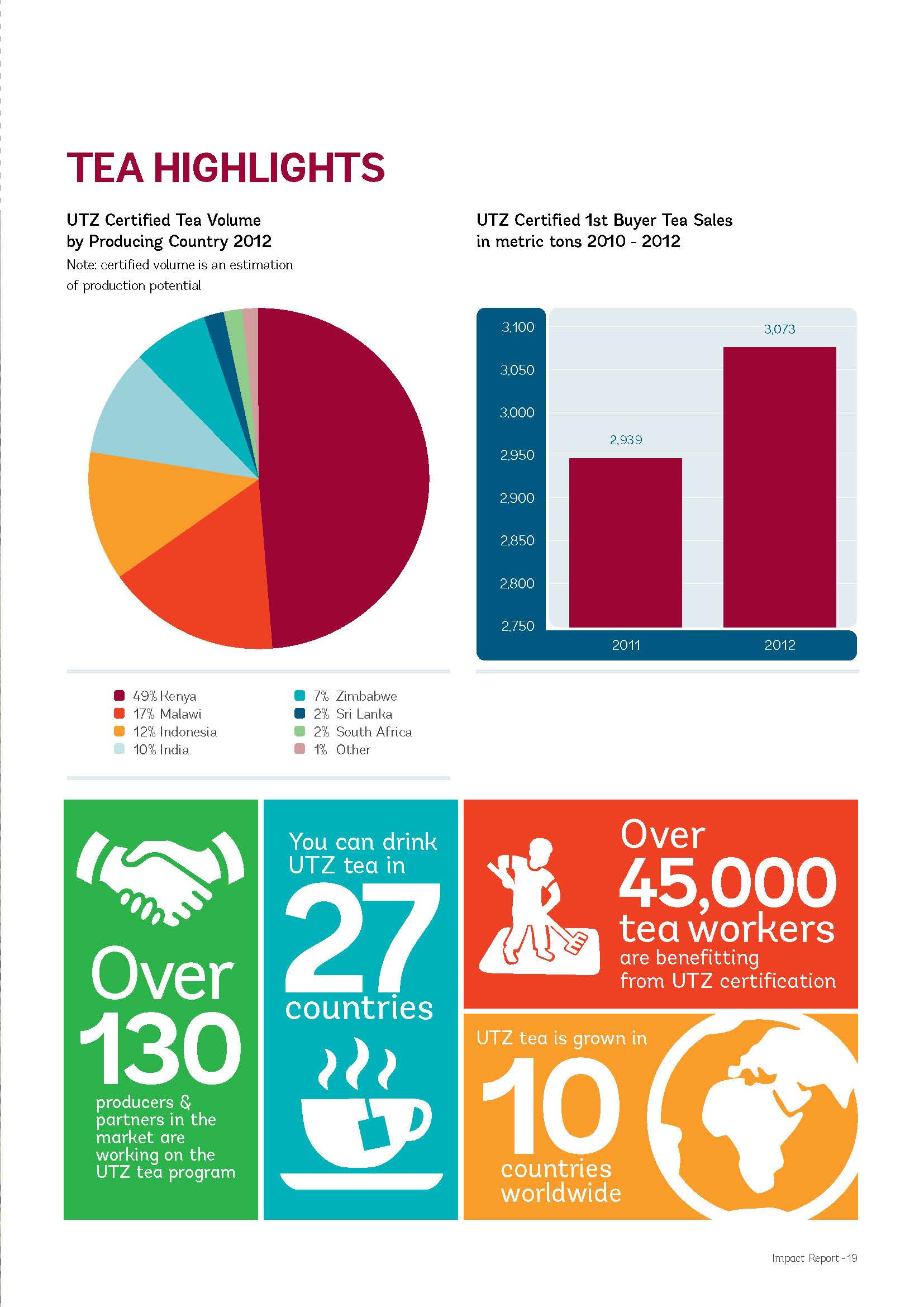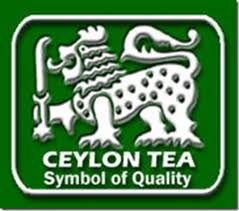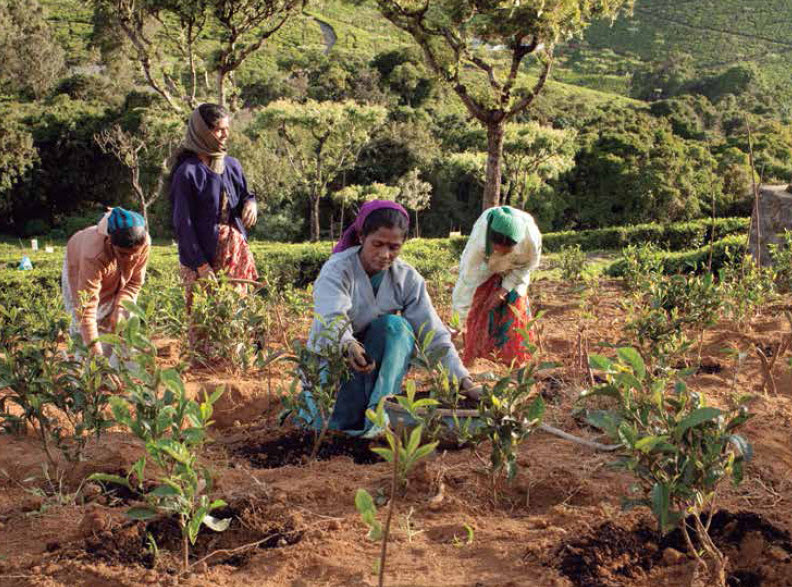What tea professionals need to start the week. —
Third party sustainability certifier UTZ finds gardens adhering to its recommended practices generate higher yield and better quality tea… a large-scale study of U.K. women on foods that offer protection against diabetes confirms that tea, chocolate and berries are the perfect afternoon snack… Sri Lanka sets a revenue record for tea exports… changes in temperature and rainfall may reduce the beneficial components of tea… researchers find hydrating with tea is equal to water (we think it’s a smidgen better)… a formidable fence on the border with Bangladesh keeps India tea growers locked out at night.
Sustainable Practices Benefit Tea Growers
AMSTERDAM, Netherlands — The UTZ certifying organization published its first Impact Report last week and the findings suggest tea growers will benefit in several ways by adopting the UTZ Code of Conduct.
The report is a compilation of findings from 24 independent research studies to assess the impact of the a regimen of sustainable practices that include training in horticulture, spare use of soil inputs and pesticides and practices to encourage biodiversity, water conservation and soil enhancement.
 Highlights from the work on tea gardens in Malawi and Kenya:
Highlights from the work on tea gardens in Malawi and Kenya:
- Kenyan tea farmers were able to improve yields by 11% from 1.13 kilos per bush in 2010 to 1.26 kilos in 2012.
- Kenyan tea farmers that received training on the UTZ Code of Conduct increased record keeping by 30%. In the same study, significantly more farmers that were trained on UTZ stated that they regularly review records on their use of inputs and production to help them adjust their farm management practices.
- Use of Personal Protective Equipment that includes breathing masks, protective foot-gear, gloves, eye protection and protective clothing rose from 3% to 37% in Kenya and from 10% to 17% in Malawi following training. The UTZ certified farmers were significantly more likely to prevent vulnerable groups, such as pregnant women and untrained workers, from applying agro chemicals.
- Tea farmers in Kenya increased income by 14% (adjusted for inflation). This was due to lower input costs, higher prices and the effect of the UTZ premium. Lower input costs included labor and fertilizer costs, with UTZ certified farmers using 22% less fertilizer per bush in 2012 than they did in 2010. In Malawi, similar results were observed. In that country 53% of tea farmers that received training reported their net income had increased compared with two years ago.
- Satisfaction levels went up in relation to quality of family welfare, relationships with neighbors and quality of farms, including access to water and electricity. Scores on satisfaction level regarding livelihood increased by an average of 25% from 2009 to 2011 among UTZ certified tea farmers in Malawi.
“It is of fundamental importance to measure the impact of our program,” said Han de Groot, executive director of UTZ Certified. “We are proud of the outcome of this report. It shows that UTZ is making a difference for more than half a million farmers and their families worldwide,” he said.
Click here to download UTZ Impact Report. Learn more: www.utzcertified.org
WebMD: Tea Lowers Diabetes Risk
The WebMD site is a treasure trove of trustworthy reporting on the health benefits of tea. Last week it cited a report in the Journal of Nutrition (Jan. 19) of the first large-scale human studies to look at how substances found in tea, chocolate and berries can protect people against diabetes. The disease has reached frightening levels in the developed countries of the world.
“Our research looked at the benefits of eating certain sub-groups of flavanoids. We focused on flavones, which are found in herbs and vegetables such as parsley, thyme and celery, and anthocyanins, found in berries, red grapes, wine and other red or blue-colored fruits and vegetables,” study leader Aedin Cassidy, of the University of East Anglia in England, said in a university news release.
The study included nearly 2,000 healthy women in the U.K. who completed food questionnaire and were tested for levels of blood sugar, insulin resistance and inflammation, according to a report on the WebMD website.
Earlier research that took place in laboratories suggested that these types of foods might affect blood sugar, which plays a role in type 2 diabetes risk, she noted. However, it was unknown how regular consumption of these ingredients might affect a person’s blood glucose and inflammation levels and insulin resistance, Cassidy said in the news release.
In the release co-author Tim Spector, of King’s College London, said the study suggests “that some components of foods that we consider unhealthy like chocolate or wine may contain some beneficial substances. If we can start to identify and separate these substances we can potentially improve healthy eating.”
 Sri Lanka Leads World in Value Added Tea Exports
Sri Lanka Leads World in Value Added Tea Exports
COLOMBO, Sri Lanka — Tea exports reached an all-time high in 2013 generating revenue of $1.5 billion for this island nation of tea growers. Production was up 7% compared to 2012 reaching 340 million kilos of tea.
The country excels in tea processing, blending and adding value to the leaves it grows. Last year 41% of its export total was value-added tea. Sri Lanka’s combination of tea blending, tea bagging factories, carton making and printing and shipping prowess makes it common to load entire containers of cello wrapped tea for market.
Plantations Industries Minister Mahinda Samarasinghe told the Daily News 2014 would be even better.
Sri Lanka has again managed to sustain the highest price of all the world’s auction centers, averaging $3.44 per kilo, he said. The tea auction center in Mombasa, in contrast, averaged $2.40 per kilo in 2013, well below the past two years. In 2012 Kenyan tea sold for an average $2.88 per kilo. Kenya is the world’s largest black tea exporter but adds value to only 8% of its exports while India, the region’s other tea powerhouse adds value to only 11% of its tea exports.
Samarasinghe said that to spur further growth the government is providing assistance to farmers to re-plant. Subsidies for small holders were increased to $2,679 per hectare (about $1,300 per acre) from $725 per acre in 2012. The funds are used to purchase fertilizer with an additional $1900 per hectare incentive to plant new tea.
Russia and the neighboring CIS countries remain the primary destination for Ceylon tea at 16% followed by Iran which received 12% of last year’s exports. Turkey, Iraq, Syria, UAE, Kuwait, Japan, Jordan and Chile round out the top 10 destinations.
Impact of Climate Change on World’s Favorite Drink
YUNNAN, China — A study funded by the National Science Foundation will investigate changes in temperature and rainfall patterns that are believed to alter not only the taste and aroma but also the potential health benefits of tea.
Science Daily reports on a research project by Tufts University biologist Colin Orians to “examine how climate change effects the concentration of chemical compounds that are responsible for tea’s stimulant, sensory and healthful properties.”
The study is based on preliminary research conducted in southwestern China’s Yunnan Province by co-principal investigator and tea expert Selena Ahmed while she was a graduate student and later Training in Education and Critical Research Skills Program (TEACRS) postdoctoral fellow at Tufts.
“Since the quality of tea is determined by a range of secondary chemicals that depend on climatic conditions, climate change can have significant consequences for tea markets,” says Orians, a professor in the Department of Biology in the School of Arts and Sciences at Tufts. “People buy and drink tea for certain qualities. If those qualities are not there, then they may not buy the tea.” Similar research is ongoing in Assam, India where R.M. Bhagat, deputy director of the Tea Research Association, based in Tocklai told Al Jezeera that “the degree of impact varies regionally, depending on distance from equator and other local conditions.”
The Tocklai tea experimental station has been recording daily weather and tea production data for more than 100 years. “We have found that the minimum temperature has risen by 1.5 degree centigrade, and the annual rainfall has reduced by 200 millimeters,” said Bhagat.
Bhagat says tea trees in Assam previously would be high yielding until 40-45 years of age, but now decline at 30-35. The resulting tea is less pungent and full-bodied. Assam was historically viewed as sub-tropical with an ambient temperature under 95º Fahrenheit (35º Celsius). The range is now 100º to 104º (38-40º C) in shaded areas, and upwards of 122º F. (50º C) in non-shaded spots. Photosynthesis slows at 95º F. and food production in the plant stops above 102º F. Tea leaves can no longer breathe and die above 104º F.
“Only time will say whether the tea trees will adapt or not, but the industry has to gear up,” he says. He recommends increasing shaded areas, alternative water systems, and using organic manure. The association is also testing clones that are resistant to climate change, he adds.
Sources: Science Daily, Al Jazeera
Staying Hydrated with Tea
It would be hard to avoid the message that everyone should be drinking more water – eight 8-ounce glasses each day. Right? Not necessarily. The concept of “8 by 8” became ingrained in society, as did the belief that only water would do. Common wisdom was that tea would make a person more dehydrated, in need of additional water intake. Unfortunately, even though this idea has been proven to be untrue, many people have not gotten the message.
According to the Institute of Medicine, drinking any beverage containing water will help keep the body hydrated. Happily, this list includes tea. “We should be telling people that beverages like tea and coffee contribute to a person’s fluid needs and despite their caffeine content, do not lead to dehydration,” wrote Spero Tsindos from La Trobe University’s Department of Dietetics & Human Nutrition in the June 2012 Australian and New Zealand Journal of Public Health.
A study sponsored by the UK Tea Advisory Panel corroborated these statements. Researchers assembled 21 volunteers who would consume four cups of tea on one day of the study and four cups of hot water on the other day of the study. (Some participants began with tea and the rest began with the water. Each person switched for the second day.) Hydration levels were measured using blood and urine samples. Researchers found no differences in hydration levels in the participants whether they consumed water or tea. Read more in The Telegraph.
 Cross-border Theft Hampers Tea Growers
Cross-border Theft Hampers Tea Growers
JALPAIGURI, West Bengal – Along Assam’s southern border with Bangladesh, tea growers report cross-border tensions are at a high. The border fence runs through tea gardens maintained by growers in the Jalpaiguri district of West Bengal. At the time the territorial boundary was established the precise location of the “zero line” was not known. During the past few years India has constructed a 4,000 kilometer, nine-foot-high fence of multi-layered barbed wire to discourage illegal immigration and smuggling. Approximately 3,200 kilometers faces Bangladesh with 1,066 kilometers bordering the State of Bengal, according to a report in the Hindu Business Line.
The fence was erected 150 yards from the zero line creating a zone ruled by India but easily accessed by Bangladesh. Tea production in this area totals 50 million kilos, valued at US$10.5 million. “Over 1000 small tea plantations, recognized by Tea Board of India, are situated in the land along the Indo Bangla border. Many have special permission of Border Security Force (BSF) guarding the international border, to plant tea,” explains Bijoy Gopal Chakroborty, President, Confederation of Indian Small Tea Growers Associations (CISTA).
Chakroborty told the Economic Times pilferage has been growing for the past several months with thieves now absconding with pumps, irrigation pipes, sprayers and farm implements. Indian growers are permitted to cross through gates into the buffer zone but must return at night.
This has escalated to large-scale green leaf theft which has “hit hard the economy of these STGs (Small Tea Growers),” he said. Growers can only complain to the security forces after the fact, since they are not allowed access their land at night. “We accept that BSF is always active everywhere. But it is impossible for them too to keep everyone out of our lands in opposite side of the fence,” tea planter P. Saha told the newspaper.
— — —
Tea Biz serves a core audience of beverage professionals in the belief that insightful journalism informs business decision making. Tea Biz reports what matters along the entire supply chain, emphasizing trustworthy sources and sound market research while discarding fluff and ignoring puffery.
Tea Biz posts are available to use in your company newsletter or website. Purchase reprint and distribution rights for single articles or commission original content. Click here for details.



